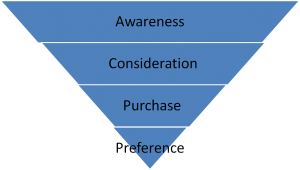New: Weekly Writer Sunday – Promotion and the Purchase Process
I'm starting a weekly Sunday blog for writers. Because so many published authors shared their knowledge with me, I also wish to pass on what I've learned to other writers. This week, I'm discussing Promotion at a high level perspective. Having spent 10 years in corporate marketing, I think it's important to understand marketing concepts prior to embarking on any promotional campaign. This is as true for a giant consumer corporation as it is for a self-employed author.
One of the biggest misperceptions I've noted is that authors think of promotional efforts as a one-to-one equation. For example, Wanda Writer decides to create a banner ad and put it up on a well-known reviewer site. Wanda is hoping this banner ad will increase sales of her book. But Wanda is missing several steps in readers' decision-making processes.
Looking at promotion from the consumer's viewpoint, and smart marketers do, you must consider the purchase process. One marketing model for the purchase process is called the Purchase Funnel as shown below.
The model makes sense, particularly for new products, new companies, revamped products, and for our purposes, debut authors. The first step is to create awareness of your brand and product. You, the author, are the brand. Why not the book? Because you will have more than one book. Your brand is the perception you create of the experiences your readers will have and come to expect when reading your books. Brand is also a promise, one that means you will consistently deliver a novel that reflects what readers expect to find in your novels. Those expectations will encompass tone, voice, characterization, and plotting. Certainly, authors can and do write in more than one genre, but in the beginning of your career, you may find it easier to establish a strong brand by first focusing on one subgenre. Whether you write in one or multiple subgenres, it's crucial to deliver a consistent reading experience.
So how do you create awareness? In my case, this starts with the publisher, specifically sales and marketing. Distribution is key as the availability of my books in key accounts is critical. My publisher also advertises in fan magazines, holds contests on Goodreads, distributes e-Newsletters to readers, and does out of the box promotions on Facebook and Twitter. Other promotions include blog tours and interviews. In turn, I create marketing pieces for them to pitch to various online sites and have an active presence on Twitter, Facebook, Goodreads, and various writing blogs and groups.
Once readers become aware of your books, the consideration phase begins. Think about your own decision process when buying a book. Factors that may sway your decision include buzz about the book, the cover, reviews, and possibly recommendations from a trusted source such as a friend. Authors can influence the consideration phase by posting excerpts of their books on their websites. Also, many publishers, such as mine, post excerpts and dear reader letters in the backs of the novels to help with the consideration phase.
The purchase phase occurs next. Obviously, the whole universe of romance readers is not your target market. Your potential target market first consists of readers who enjoy your subgenre. Other factors include tone, voice, pacing, plotting, etc. We all know that the reading experience is highly personal. Have you ever recommended a book you loved to a friend, only to learn she wasn't as blown away as you? That's the personal factor that accounts for the wildly different reactions you may see in reviews for any particular book.
Preference is the final step in the purchase process and is about loyalty. I love Loretta Chase's books and am a devoted reader. I recently told a friend that Loretta Chase could put the Tasmanian devil on her cover, and I'd buy the book, regardless.  That's the power of loyalty. However, I should add that loyalty depends on delivering a consistent experience that aligns with the author's brand.
That's the power of loyalty. However, I should add that loyalty depends on delivering a consistent experience that aligns with the author's brand.
Next Sunday, I'll address branding and perception in more detail. Meanwhile, be thinking about how companies influence the perceptions of consumers. Here's an old Apple iPOD commercial to consider. What emotional experience is Apple hoping to evoke in the consumer? Write down your top of the mind responses and leave them in a comment for this blog. Cheers!




